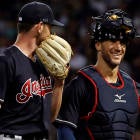Indians made calculated financial decision by trading catcher Yan Gomes to Nationals
Gomes' volatility was probably too much for Cleveland to bank on
The Cleveland Indians are in an unusual spot. They've won the American League Central three seasons in a row, and will probably enter next spring favored to claim the division once again. Yet Cleveland seems intent on retooling its roster this winter by prioritizing budgetary efficiency over raw talent, counter the way most contenders do. Hence making Corey Kluber, Carlos Carrasco and Trevor Bauer available; hence permitting Michael Brantley and Josh Donaldson to walk in free agency; hence trading Yan Gomes to the Washington Nationals.
That last bit -- the trade that sent Gomes to D.C. -- flew under the radar since it went down on Friday night and the return didn't involve a top prospect. Instead the swap netted Cleveland toolsy outfielder Daniel Johnson, hard-throwing righty Jefry Rodriguez and a player to be named later. Johnson could develop into a solid player and Cleveland's well-regarded development staff will try to milk more from Rodriguez's arm. Still, that's not an inspiring return.
So why did Cleveland make this deal? Likely with a few factors other than prospects in mind.
It's true that Gomes is coming off an All-Star season in which he hit .266/.313/.449 with 16 home runs. That's good for a 103 OPS+, the 10th-best mark among catchers with 300-plus plate appearances. Add in his above-average defense -- he's a quality framer and his quick transfer helps him deter base stealers -- and it's safe to say he was a top-10 backstop last season. But for as good as Gomes' season was, it was also an outlier. Though he'd prospered at the plate earlier in his career (he won a Silver Slugger Award in 2014), he hadn't hit well in recent years. From 2015 through the 2017 season, he'd posted a 67 OPS+ in 91 games per season; for reference, Cleveland's light-hitting reserve Roberto Perez has a career 70 OPS+.
It's possible Gomes will continue to hit and that his past struggles are behind him (he missed time due to a separate shoulder that undoubtedly hindered his stick). Still, there's also a chance he reverts to being a mitt-only catcher. That's fine; there's value in having a strong defender behind the plate. It's just that Gomes's volatility complicates everything for a budget-conscious club like Cleveland.
Consider that Gomes is going to make $7 million next season no matter what he does at the plate. His contract includes a pair of club options. If those aren't exercised, he'll walk away with $2 million in total buyouts. That means Gomes is owed at least $9 million. That's not a lot in a $10 billion industry, but it matters when a team's owner gives the directive to cut costs. Remember how Cleveland is reportedly shopping its top starters? Kluber is set to make $13 million; Carrasco $9 million; Bauer is projected to make $12 million through arbitration. Shedding Gomes's $9 million offers nearly the same amount of financial relief as moving any of the three -- and it's fair to write that each is considerably more important to their chances in 2019.
That last part is especially true if Cleveland believes Gomes is due to regress. Public projection systems do -- FanGraphs' Steamer, for instance, has Gomes dropping to an 86 wRC+, or about the same level of production relative to the league as his 2017 season. Should the Indians believe that, then they likely believe they can get similar or equal production at a reduced price. How might they do that? By signing defensive whiz Martin Maldonado to a two-year deal worth around $6 million, the way the Texas Rangers did with Jeff Mathis; by gambling (and winning) on Devin Mesoraco staying healthy; by signing Robinson Chirinos and living with the defensive drop; by lucking out and having Wilson Ramos slip through the cracks; or so on and so forth.
Cleveland could, alternatively, stand pat and enter next season with Perez and prospect Eric Haase behind the plate. Haase has a strong arm and raw power, but he reached base less than 29 percent of the time last season in Triple-A, suggesting he's not ready for the Show.
Whatever Cleveland does, the team's decision to move on from Gomes is probably a smart one financially based on what we know. It's just unfortunate that this is how baseball operates these days, with perennial contenders focused more on the bottom line than the pennant.


















